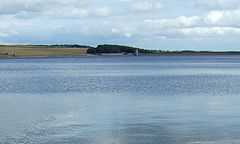Derwent Reservoir (North East England)
| Derwent Reservoir | |
|---|---|
 | |
| Location | County Durham / Northumberland |
| Coordinates | 54°52′0″N 1°59′0″W / 54.86667°N 1.98333°WCoordinates: 54°52′0″N 1°59′0″W / 54.86667°N 1.98333°W |
| Lake type | Reservoir |
| Primary inflows | River Derwent |
| Primary outflows | River Derwent |
| Basin countries | United Kingdom |
Derwent Reservoir is a reservoir on the River Derwent, on the border between County Durham and Northumberland, in England. It is west of Consett.It is one of the biggest inland waters in England. It is 3.5 miles (5.6 km) long) and covers an area of 4 km² and has a maximum depth of 100 ft (30m) and when full, holds 11,000 million gallons (50,000,000m³).[1]
The reservoir is a key part of the water supply network in north east England (which is owned and managed by Northumbrian Water) as it is the principal water source for the Tyne and Wear metropolitan area.
The flow of the River Derwent can be supplemented, when necessary, by water transferred from the much larger Kielder Water in Northumberland. However this cannot top up the reservoir itself
Sediment within the reservoir has been found to contain elevated levels of zinc, lead and cadmium. These have drained into the reservoir from areas of previous mining activity around Blanchland. Consequently, populations of macroscopic plants in the reservoir are relatively low.[2]
Derwent Reservoir also hosts a sailing club, which holds many events throughout the year, including windsurfing, sailing, running and triathlons.
The reservoir also has hydro electric plant installed, with a rating of 97 kilowatts.[3]
See also
- British Waterways
- List of reservoirs and dams in the United Kingdom
External links
| Wikimedia Commons has media related to Derwent Reservoir (North East England). |
References
- ↑ "Derwent-facts for 40 years". Northumbrian Water Plc http://www.nwl.co.uk/''. Retrieved 15 July 2012.
- ↑ Harding, JPC, Whitten, BA (1978) Zinc, Cadmium and Lead in Water, Sediment and Submerged Plants of the Derwent Reservoir, Northern England. Water Research, Vol. 12, p307-316.
- ↑ "Derwent". http://www.r-e-a.net/''. Retrieved 5 August 2009.
